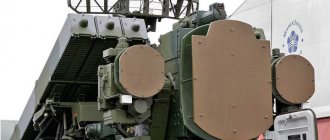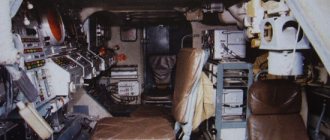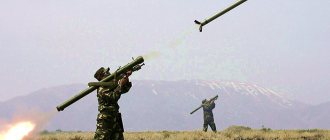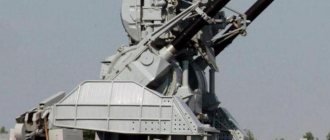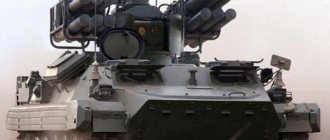General information
Guided missiles are the most important part, which also includes the ATGM launcher and guidance systems. The so-called solid fuel is used as an energy source, and the warhead (warhead) is most often equipped with a shaped charge.
Since they began to be equipped with composite armor and active dynamic protection systems, new anti-tank missiles are also evolving. The single cumulative warhead has been replaced by tandem ammunition. As a rule, these are two shaped charges located one behind the other. When they explode, two are formed in succession, with more effective armor penetration. If a single charge “pierces” up to 600 mm, then tandem ones – 1200 mm or more. In this case, the elements of dynamic protection “extinguish” only the first jet, and the second does not lose its destructive ability.
ATGMs can also be equipped with a thermobaric warhead, which creates the effect of a volumetric explosion. When triggered, aerosols are sprayed in the form of a cloud, which then detonate, covering a significant area in the fire zone.
These types of ammunition include ATGM "Cornet" (Russian Federation), "Milan" (France-Germany), "Javelin" (USA), "Spike" (Israel) and others.
Monopulse Doppler active radar homing head (ARGSN) 9B-1103M
ARGSN 9B-1103M is designed for installation on air-to-air and surface-to-air missiles. Operating modes 9B-1103M is completely autonomous - it operates according to initial target designation data without radar support (fire-and-forget mode). It provides a reprogramming mode when the user, depending on the conditions of use of the ARGSN, can enter a new program for the on-board computer. The ARGSN includes a controlled coordinator with an antenna; transmitter; receiving channel; a reprogrammable on-board computer system consisting of a control computer and a signal processor.
ARGSN 9B-1103M provides:
- search, capture and tracking of moving targets based on preliminary target designation of air carrier radars or anti-aircraft systems,
- measurement of angular coordinates, angular velocities of targets and missile-target approach speed,
- generation and transmission of signals for missile control systems via a digital communication line.
Compound:
- Coordinator
- Transmitter
- Monopulse direction finding receiving channel
- Digital computer system consisting of a control machine and a signal processor.
Performance characteristics of ARGSN 9B-1103M
- Target acquisition range with EPR 5 m2, km – 25
- Range of radio correction channel (with SUV of MIG-29 type aircraft), km – up to 50
- Case diameter, mm – 200
- Length (without fairing), mm – 600
- Weight (without fairing), kg – no more than 14.5
- Ready time after preliminary switching on for 2 minutes, s – no more than 1.5
Based on budget
Speaking about the strike capabilities of ships in the near zone, it should be noted that the Uran anti-ship missiles are quite sufficient for a corvette, but we do not have a light launcher for the much-needed Anti-Submarine Missiles (ASM) “Response”. Their use today is possible only from vertical launchers UKSK (universal ship-based firing complex) for Caliber missiles. This solution has already been implemented in the modification of Project 20380 - Project 20385. Accordingly, only Project 20385 corvettes should be considered for further serial construction.
The thesis about the uselessness of PLR due to the presence of a PLO helicopter on a corvette does not stand up to criticism. Our Ka-27M is an example of a quarter-century outdated, extremely ineffective anti-submarine helicopter. It got to the point that during the next modernization, the PLO helicopter lost its anti-submarine search and targeting system, which the new Ka-27M simply does not have. In this situation, only the Answer PLR allows our corvettes to be hunters and not game in relation to enemy submarines.
Let's summarize briefly.
The mass construction of corvettes with the extremely expensive IBMC Zaslon air defense weapon, which still does not support the use of air defense weapons, will lead to the expenditure of huge budget funds on ineffective systems that do not meet the air defense requirements of corvettes, but for financial reasons preclude their mass construction.
It is necessary to modernize project 22380(5) in terms of installing the serial Pozitiv-M radar and radio correction equipment for missile defense systems. Taking into account the need to have anti-submarine missiles “Otvet” and the extreme feasibility of ensuring the possibility of using “Calibers” for a series of new corvettes, Project 20385 with UKSK is needed (with its modification for “Positive-M” and radio correction of missiles).
The laying down of new corvettes of Project 20380(5) does not solve the problem of the near zone; a mass series of small corvettes for protecting the water area is needed. And something needs to be done with our naval aviation. First of all, a complete and modern modernization of the Ka-27M helicopter is needed, and not what we received today. However, this is a topic for another discussion.
Maxim Klimov
Newspaper “Military-Industrial Courier”, published in issue No. 35 (848) for September 15, 2022
Application of ATGM: attack
First generation weapons require careful training of the shooter. When aiming a warhead and subsequent remote control, the same three-point principle is used:
- vizier's crosshair;
- rocket on trajectory;
- hit target.
Having fired, the operator must simultaneously monitor the aiming mark, projectile tracer and moving target through an optical sight, and manually issue control commands. They are transmitted aboard the rocket via wires trailing behind it. Their use imposes restrictions on the speed of ATGMs: 150-200 m/s.
If in the heat of battle the wire is interrupted by shrapnel, the projectile becomes uncontrollable. The low flight speed allowed the armored vehicles to perform evasive maneuvers (if the distance allowed), and the crew, forced to control the trajectory of the warhead, was vulnerable. However, the probability of a hit is very high - 60-70%.
Excerpt characterizing Redoubt (anti-aircraft missile system)
He, apparently, was so busy that he forgot to even be respectful to the commander-in-chief: he interrupted him, spoke quickly, unclearly, without looking into the face of his interlocutor, without answering the questions asked of him, was stained with dirt and looked pitiful, exhausted, confused and at the same time arrogant and proud. Kutuzov occupied a small noble castle near Ostralitsy. In the large living room, which became the office of the commander-in-chief, gathered: Kutuzov himself, Weyrother and members of the military council. They were drinking tea. They were only waiting for Prince Bagration to begin the military council. At 8 o'clock Bagration's orderly arrived with the news that the prince could not be there. Prince Andrei came to report this to the commander-in-chief and, taking advantage of the permission previously given to him by Kutuzov to be present at the council, remained in the room. “Since Prince Bagration will not be there, we can begin,” said Weyrother, hastily getting up from his place and approaching the table on which a huge map of the surrounding area of Brünn was laid out. Kutuzov, in an unbuttoned uniform, from which, as if freed, his fat neck floated out onto the collar, sat in a Voltaire chair, placing his plump old hands symmetrically on the armrests, and was almost asleep. At the sound of Weyrother's voice, he forced his only eye open. “Yes, yes, please, otherwise it’s too late,” he said and, nodding his head, lowered it and closed his eyes again. If at first the members of the council thought that Kutuzov was pretending to be asleep, then the sounds that he made with his nose during the subsequent reading proved that at that moment for the commander-in-chief it was about much more important than the desire to show his contempt for the disposition or for anything else. be that as it may: for him it was about the irrepressible satisfaction of a human need - sleep. He was really asleep. Weyrother, with the movement of a man too busy to waste even one minute of time, looked at Kutuzov and, making sure that he was sleeping, took the paper and in a loud, monotonous tone began to read the disposition of the future battle under the title, which he also read: “Disposition for attack of the enemy position behind Kobelnitsa and Sokolnitsa, November 20, 1805." The disposition was very complex and difficult. The original disposition included: DA Der Feind Mit Seinerien Linken Fluegel An Die Mit Wald Bedecten Berge Lehnt Sich Mit Seinerien Fluegs Kobeinitz Und Sokolienitz Hinter Die Dort BEFIND IChen Teiche Zieht, Wir IM Geegentheil Mit Unserem Linken Fluegel Seineen Rechten Sehr DeboDiren, So Ist es vortheilhaft letzteren Fluegel des Feindes zu attakiren, besondere wenn wir die Doerfer Sokolienitz und Kobelienitz im Besitze haben, wodurch wir dem Feind zugleich in die Flanke fallen und ihn auf der Flaeche zwischen Schlapanitz und dem Thuerassa Walde verfolgen koennen, indem wir dem De filen von Schlapanitz und Bellowitz ausweichen, welche die feindliche Front decken. Zu dieserien Endzwecke ist es noethig... Die erste Kolonne Marieschirt... die zweite Kolonne Marieschirt... die dritte Kolonne Marieschirt... [Since the enemy rests his left wing on the forest-covered mountains, and his right wing stretches along Kobelnitsa and Sokolnitsa behind the ponds located there, and we On the contrary, if our left wing surpasses his right wing, then it is advantageous for us to attack this last enemy wing, especially if we occupy the villages of Sokolnits and Kobelnits, being given the opportunity to attack the enemy’s flank and pursue him in the plain between Shlapanits and the Tyuras forest, avoiding with those defiles between Shlapanitz and Belowitz, which covered the enemy front. For this purpose it is necessary... The first column marches... the second column marches... the third column marches...], etc., Weyrother read. The generals seemed reluctant to listen to the difficult disposition. The blond, tall General Buxhoeveden stood with his back against the wall, and, fixing his eyes on the burning candle, it seemed that he was not listening and did not even want to be thought that he was listening. Directly opposite Weyrother, fixing his shining open eyes on him, in a militant pose, resting his hands with his elbows outstretched on his knees, sat the ruddy Miloradovich with his mustache and shoulders raised. He remained stubbornly silent, looking into Weyrother’s face, and only took his eyes off him when the Austrian chief of staff fell silent. At this time, Miloradovich looked significantly back at the other generals. But from the meaning of this significant glance it was impossible to understand whether he agreed or disagreed, was pleased or dissatisfied with the disposition. Count Langeron sat closest to Weyrother and, with a subtle smile of a southern French face that did not leave him throughout the reading, looked at his thin fingers, quickly turning the corners of a golden snuffbox with a portrait. In the middle of one of the longest periods, he stopped the rotating movement of the snuffbox, raised his head and, with an unpleasant politeness at the very ends of his thin lips, interrupted Weyrother and wanted to say something; but the Austrian general, without interrupting his reading, frowned angrily and waved his elbows, as if saying: later, then you will tell me your thoughts, now if you please look at the map and listen. Langeron raised his eyes upward with an expression of bewilderment, looked back at Miloradovich, as if looking for an explanation, but, meeting Miloradovich’s significant, meaningless gaze, he sadly lowered his eyes and again began to twirl the snuffbox. “Une lecon de geographie, [A lesson from geography,"] he said as if to himself, but loud enough to be heard. Przhebyshevsky, with respectful but dignified courtesy, bent his ear to Weyrother, looking like a man absorbed in attention. Small in stature Dokhturov sat directly opposite Weyrother with a diligent and modest look and, bending over the laid out map, conscientiously studied the dispositions and the terrain unknown to him. Several times he asked Weyrother to repeat the words he had heard poorly and the difficult names of the villages. Weyrother fulfilled his wish, and Dokhturov wrote it down. When the reading, which lasted more than an hour, was over, Langeron, again stopping his snuff-box and without looking at Weyrother or anyone in particular, began to talk about how difficult it was to carry out such a disposition, where the position of the enemy is supposed to be known, whereas this position could be we do not know, since the enemy is on the move. Langeron's objections were well-founded, but it was obvious that the purpose of these objections was primarily the desire to make General Weyrother feel, as self-confidently as schoolchildren reading his disposition, that he was dealing not only with fools, but with people who could learn in military affairs. When the monotonous sound of Weyrother’s voice fell silent, Kutuzov opened the chapter, like a miller who wakes up during a break in the soporific sound of the mill wheels, listened to what Langeron was saying, and, as if saying: “And you’re still talking about this nonsense!” hastily closed his eyes and lowered his head even lower. Trying to insult Weyrother in his author's military pride as sarcastically as possible, Langeron argued that Bonaparte could easily attack, instead of being attacked, and as a result make this whole disposition completely useless. Weyrother responded to all objections with a firm, contemptuous smile, obviously prepared in advance for any objection, no matter what they said to him. “If he could attack us, he would do it today,” he said. “You therefore think that he is powerless,” said Langeron. “A lot, if he has 40 thousand troops,” Weyrother answered with the smile of a doctor to whom a doctor wants to indicate a cure. “In this case, he is going to his death, waiting for our attack,” Langeron said with a thin ironic smile, looking back at the nearest Miloradovich for confirmation. But Miloradovich, obviously, at that moment was thinking least of all about what the generals were arguing about. “Ma foi, [By God,” he said, “tomorrow we will see everything on the battlefield.” Weyrother grinned again with that smile that said that it was funny and strange for him to meet objections from the Russian generals and to prove what not only he himself was too sure of, but what the emperors were sure of. “The enemy has put out the fires, and a continuous noise is heard in his camp,” he said. - What does it mean? “Either he moves away, which is the only thing we should be afraid of, or he changes his position (he grinned). But even if he took a position in Tyuras, he only saves us from a lot of trouble, and all the orders, down to the smallest detail, remain the same. “How then?” said Prince Andrei, who had been waiting for a long time for an opportunity to express his doubts. Kutuzov woke up, cleared his throat heavily and looked around at the generals. “Gentlemen, the disposition for tomorrow, even today (because it’s already the first hour), cannot be changed,” he said. “You heard her, and we will all do our duty.” And before a battle, there is nothing more important... (he paused) than getting a good night's sleep.
